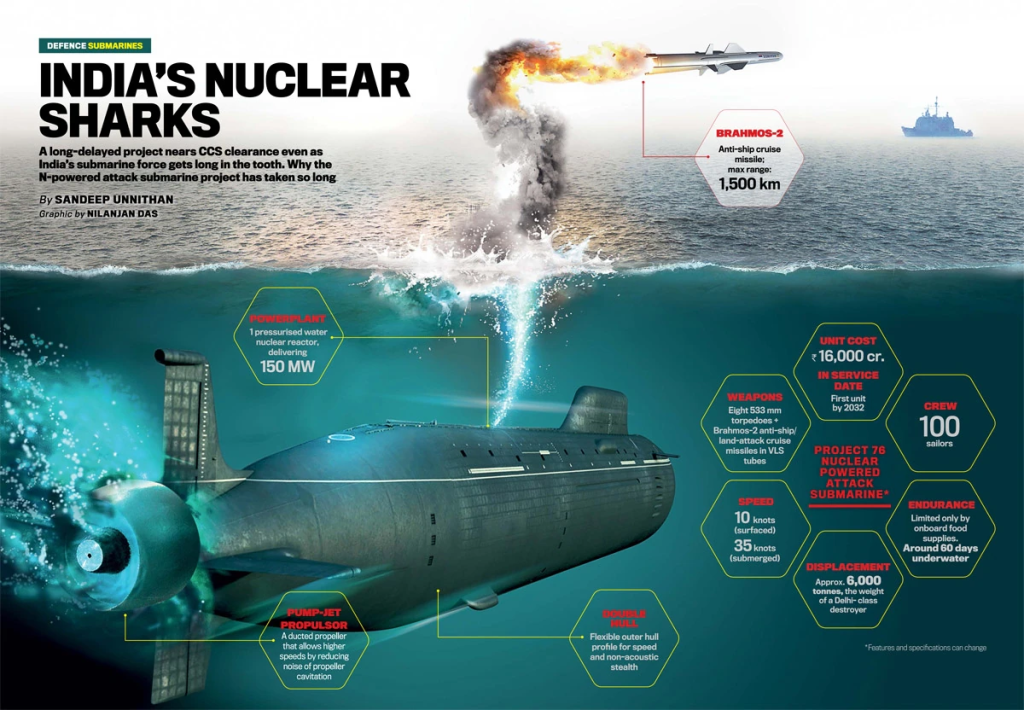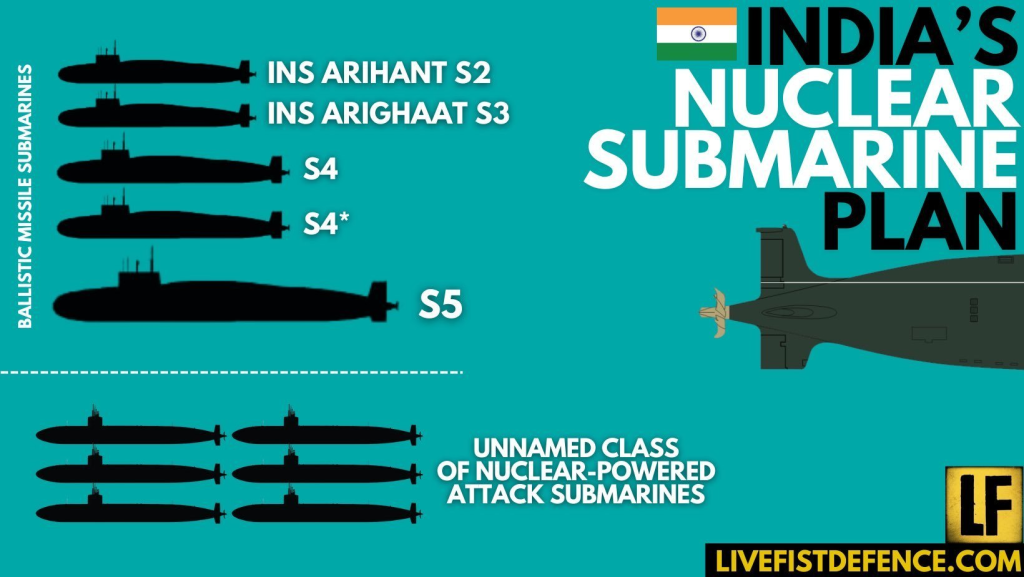
After years of delay and uncertainty, the Indian Government approved funding Wednesday for one of India’s most ambitious and crucial defence projects — homegrown nuclear-powered attack submarines. The country’s apex Cabinet Committee on Security green-flagged the construction of the first 2 of a planned six such submarines for the Indian Navy.
With a 7,500+ km coastline and enormous area of responsibility across the Indian Ocean, India’s submarine force levels have been critically low for years, with the navy entirely dependent on a depleting fleet of conventional diesel-electric submarines. India’s strategic weapons complex has built and delivered two nuclear-powered ballistic missile submarines (SSBN) — INS Arihant and INS Arighaat. Unlike SSBNs, which are part of India’s nuclear deterrent, functioning like last resort bombers that will deploy nuclear weapons if India comes under attack, the SSN project cleared by the Indian Government seeks to build long endurance submarines for regular naval use — fighters built to control ocean territory, attack ships and hunt other submarines.
The Indian Navy has so far operated SSNs twice, both leased boats from Russia. The first, named INS Chakra, was Charlie-class submarine that operated from 1987-1991. The second, also named INS Chakra, was an Akula-class submarine that operated for a decade from 2011-2021. A second Akula-class submarine has widely been reported to be in the works for India’s third such leasing.
The Indian SSNs are said to be 6,000 tonne boats that will be powered by pressure water nuclear power reactors more capable than the type powering the two SSBNs in service. As reported in India Today magazine, each boat will cost Rs 16,000 crore and sport torpedoes and anti-ship/land attack cruise missiles.

India’s maritime boundaries are vulnerable to threats from neighboring rivals, primarily China and Pakistan. China, in particular, which sports an expanding SSN fleet despite recent setbacks in a new class, has been expanding its naval presence in the Indian Ocean. Additionally, Chinese nuclear and conventional submarines at least attempt to regularly patrol the Indian Ocean. The Chinese People’s Liberation Army Navy (PLAN) is also continuously adding advanced nuclear vessels to its fleet. By contrast, India’s submarine force is largely composed of aging diesel-electric submarines, which are limited in range and endurance. Diesel-electric submarines require frequent surfacing to recharge their batteries, making them vulnerable to detection by advanced anti-submarine warfare (ASW) technologies.
Only an Indian SSN fleet will put the Indian Navy in a position to meaningfully push back. SSNs are faster, have longer endurance, and can remain submerged for months, making them ideal for sustained surveillance, deterrence, and power projection. They are difficult to detect and can carry a range of weapons, from torpedoes to cruise missiles, thus providing India with the ability to respond to threats both on and beneath the sea.
While India has already developed something of a rhythm now with SSBNs, exemplified by the Arihant-class vessels, its dependence on foreign suppliers for conventional attack submarines still persists. The Indian Navy is sea-testing the last of its India-built French Scorpene class submarines, with two more likely to be built on the same line. The follow-up program Project 75I that seeks to build six more conventional submarines on a new line waits in the wings, with German, Russian and Spanish (apart from France) contenders hoping to be chosen. With the SSN program, India leaps straight into designing and building its very own SSNs without having first developed its own conventionally powered attack submarines. Operating a fleet of Russian Kilo-class, German Type 209 and French Scorpene class conventional submarines creates potential strategic vulnerabilities, especially during times of conflict when access to spare parts, maintenance, or additional platforms could be restricted due to geopolitical factors.

The rationale is that developing homegrown SSNs would eliminate these dependencies and create a sustainable ecosystem for defense manufacturing within India. The “Atmanirbhar Bharat” (self-reliant India) initiative emphasizes the need for indigenous defense production. By focusing on nuclear submarines, India can develop cutting-edge technology domestically, reduce its reliance on foreign military technology, and create a robust industrial base capable of producing critical platforms. This would also contribute to job creation and technological innovation across multiple sectors.
SSNs are often considered the pinnacle of naval capability because of their versatility in both offensive and defensive roles. They can operate as “silent hunters,” stalking enemy vessels, including surface ships and submarines, without being detected. In addition, SSNs are capable of launching precise strikes on land targets using cruise missiles. This gives them an edge in both naval battles and land-attack missions, further enhancing India’s combat capabilities.
As with the SSBN program, Indian private sector giant L&T would lead the development of the Indian SSNs. Indigenously developing nuclear-powered attack submarines would also push India’s defense and technology sectors to new heights. The research, development, and production of such complex platforms require advancements in nuclear propulsion, stealth technology, sonar systems, and weapons integration. An entire ecosystem of strategic technology companies stand to be pushed to the next level by this program.

India should go for nuclear submarines instead of diesel electric submarines because of their advantage . India has a vast sea cost and have to petrol across Indian Ocean. China has more nuclear submarines then us hence India should raise nuclear fleet to mitigate thread from China and Pakistan
I’m Proud of my Nation.
India should develop its own technology based on Vedic scriptures because it is pure science.
India is too late and doing to little it’s Military Capabilities
.
Poorly written … what’s the Tonnage ? 5000 Tons ? 8000 Tons ? Two reactors ? Twin Elect Motor jet propulsion ? 40 MW each via two steam turbines ? 35 knots submerged? 500
meter max depth ? May be 650 meters ?
ভারত মহাসাগর পাহারা দিতে ডিজেল – ইলেকট্রিক সাবমেরিন চলনশীল হলেও , গুপ্তচর কাজে ছোট্ট ফুটবল সাবমেরিন ( গভীর সমুদ্রের জন্য ) , ও দূরবর্তী দেশে হুমকি স্বরূপ টহলদারীতে পাঠাতে , কার্যকরণ কার্য সম্পাদন করতে নিউক্লিয়ার পাওয়ার সাবমেরিন নেহাত ই প্রয়োজন ।
এছাড়া কিছু দিনের মধ্যেই অস্ট্রেলিয়া নেভিতে 12 টি নিউক্লিয়ার পাওয়ার সাবমেরিন সংযোজিত হতে চলেছে ।
* তায় এখনই প্রস্তুতি নেওয়া দরকার ।
Such a glorious moment for us. we proud of our nevy force.
Jai Hind, Jai BJP, Jai MrModi.